
Wenceslaus I, Wenceslas I or Václav the Good was the Prince (kníže) of Bohemia from 921 until his death, probably in 935. According to the legend, he was assassinated by his younger brother, Boleslaus the Cruel.
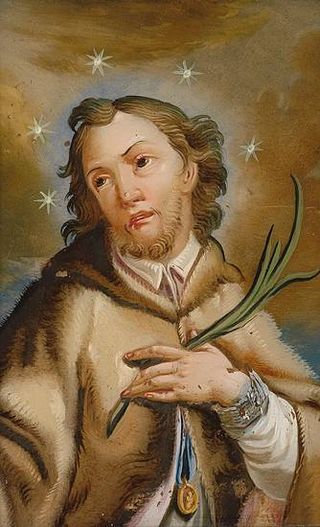
John of Nepomuk was a saint of Bohemia who was drowned in the Vltava river at the behest of King Wenceslaus IV of Bohemia. Later accounts state that he was the confessor of the queen of Bohemia and refused to divulge the secrets of the confessional. On the basis of this account, John of Nepomuk is considered the first martyr of the Seal of the Confessional, a patron against calumnies and, because of the manner of his death, a protector from floods and drowning.

Josef Václav Myslbek was a Czech sculptor and medalist credited with founding the modern Czech sculpting style.

Vyšehrad is a historic fort in Prague, Czech Republic, just over 3 km southeast of Prague Castle, on the east bank of the Vltava River. It was probably built in the 10th century. Inside the fort are the Basilica of St. Peter and St. Paul and the Vyšehrad Cemetery, containing the remains of many famous Czechs, such as Antonín Dvořák, Bedřich Smetana, Karel Čapek, and Alphonse Mucha. It also contains Prague's oldest Rotunda of St. Martin, from the 11th century.

Wenceslas Square is one of the main city squares and the centre of the business and cultural communities in the New Town of Prague, Czech Republic. Many historical events occurred there, and it is a traditional setting for demonstrations, celebrations, and other public gatherings. It is also the place with the busiest pedestrian traffic in the whole country. The square is named after Saint Wenceslas, the patron saint of Bohemia. It is part of the historic centre of Prague, a World Heritage Site.
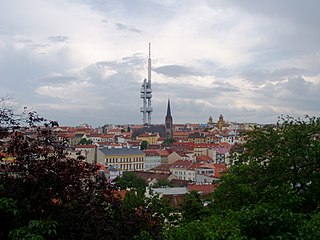
Žižkov is a cadastral district of Prague, Czech Republic.
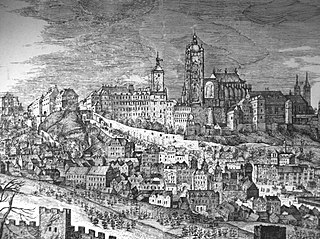
The history of Prague covers more than a thousand years, during which time the city grew from the Vyšehrad Castle to the capital of a modern European state, the Czech Republic.

Johann-Georg Bendl(Czech pronunciation:[ˈjohaŋˈɡɛorɡˈbɛndl̩]) or Jan Jiří Bendl was a Baroque sculptor, who worked mainly in Prague.
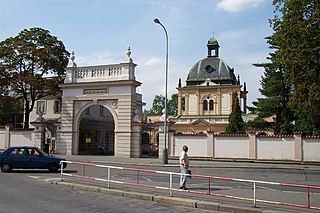
The New Jewish Cemetery in Žižkov, Prague, Czech Republic, was established in 1890 to relieve the space problem at the Old Jewish cemetery in Žižkov, where the Žižkov Television Tower now stands. It is about 10 times bigger than the Old Jewish Cemetery in Josefov and provides space for approximately 100,000 graves, therefore having the capacity to serve for a whole century. There is also a specially designated area for urns, though the Jewish tradition does not allow cremation. The cemetery is still in use today and operated by the Jewish Community in Prague.
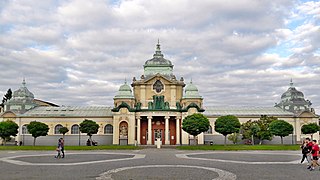
The Lapidarium is a lapidarium and a part of the National Museum in Prague, Czech Republic. It is the largest permanent exhibition of historical collections of stone sculpture, tombs and architectonical fragments originating from Bohemia, mostly from Prague.

Josef Calanza Max was a German-Czech sculptor. His brother was the sculptor Emanuel Max.

Emanuel Max, after 1876: Ritter von Wachstein was a German-Czech sculptor. His brother was the sculptor Josef Max.

The statue of Saint Wenceslas in Prague, Czech Republic depicts Wenceslaus I, Duke of Bohemia. It is installed at Wenceslas Square.
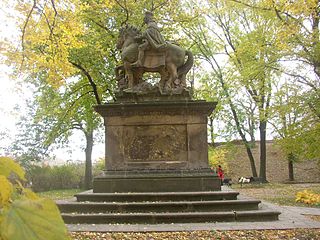
The statue of Saint Wenceslas is an outdoor sculpture by Johann-Georg Bendl from 1680, installed at Vyšehrad, Prague, Czech Republic. The statue formerly stood in the middle of Wenceslas Square, near Grandhotel Evropa, but was moved to Vyšehrad in 1879.

The following outline is provided as an overview of and topical guide to Prague:

Náměšť nad Oslavou bridge is a baroque bridge in the town of Náměšť nad Oslavou in the Czech Republic. It is an arched road bridge with sculptural decoration by Josef Winterhalder. It is the second largest Czech bridge with the richest sculptural decoration following the Charles Bridge hence it is sometimes referred to as the "Little Charles Bridge". It was built by Count Václav Adrian of Enkenvoirt in 1737.The statues were added around 1744 when they were ordained. Today the bridge is designed for pedestrian traffic only.